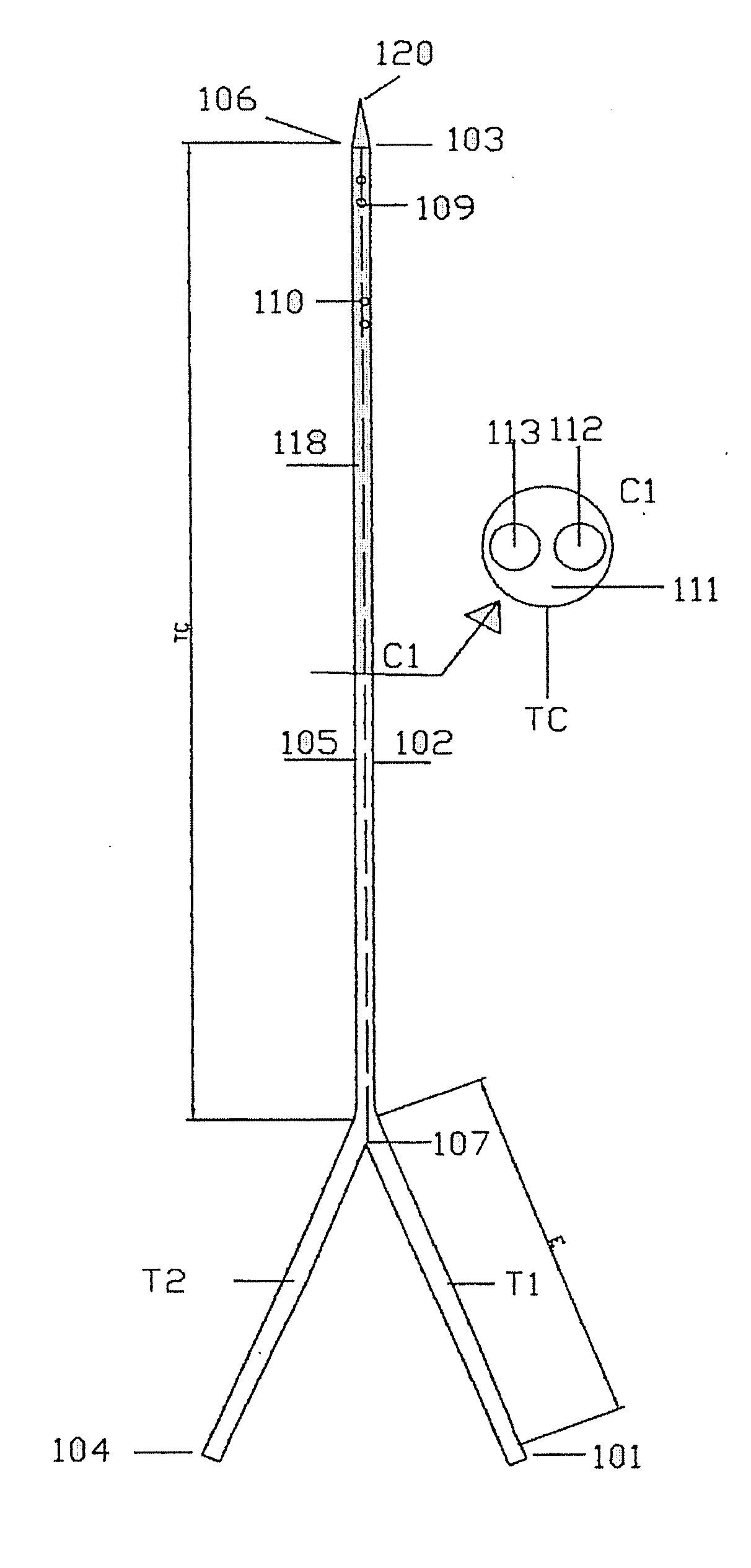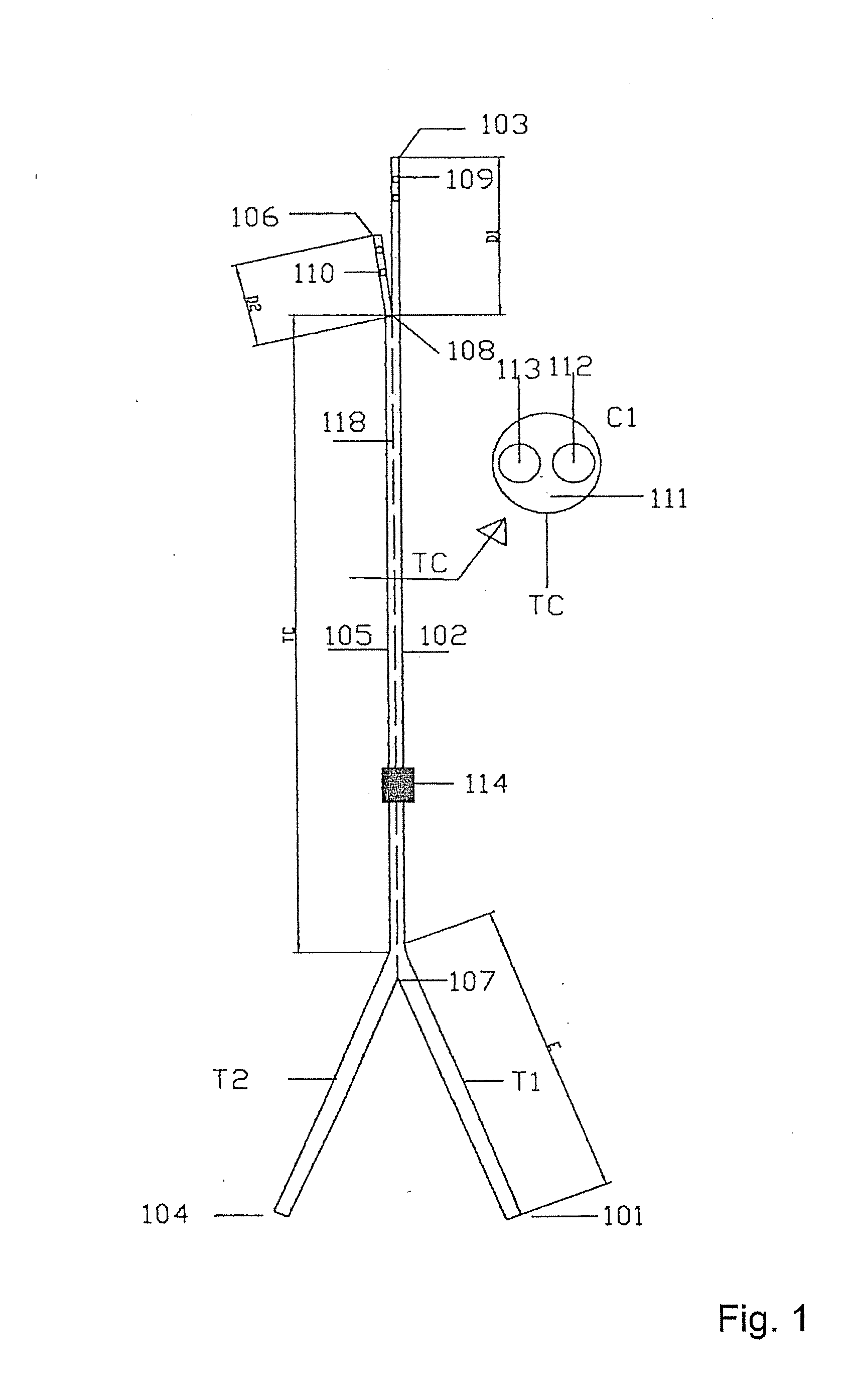Multitube catheter
a multi-tube catheter and catheter tube technology, which is applied in the direction of multi-lumen catheters, intravenous devices, medical syringes, etc., can solve the problems of increased catheterization procedure risks, leakage of catheter tubes, and only possible techniques
- Summary
- Abstract
- Description
- Claims
- Application Information
AI Technical Summary
Benefits of technology
Problems solved by technology
Method used
Image
Examples
first embodiment
A First Embodiment
[0052]FIG. 1 illustrates one embodiment of the present invention, where a catheter assembly has at least two lumens. The illustration of two lumens is exemplary, and the scope of the invention encompasses catheters having more than two lumens.
[0053]The catheter assembly includes first tube T1 which has a proximal end 101 and a distal end 103. The catheter assembly includes second tube T2 which has a proximal end 104 and a distal end 106. The first tube T1 and the second tube T2 are united (fused) at catheter shaft TC as a result of fusion of a portion 104 of first tube T1 and the 105 of second tube T2.
[0054]The catheter assembly can be provided (manufactured) so that the first distal end tube D1 and the second distal end tube D2 are splitable (releasably attached) or separate at their respective distal ends. Splitable is defined as releasably attached, meaning the first and the second distal end tubes D1 and D2 are fused, or otherwise attached, so that only minor f...
second embodiment
A Second Embodiment
[0067]FIG. 2 illustrates another embodiment of the present invention, where a catheter assembly has at least two lumens. The illustration of two lumens is exemplary, and the scope of the invention encompasses catheters having more than two lumens.
[0068]The catheter assembly includes first tube T1 which has a proximal end 101 and a distal end 103. The catheter assembly includes a shorter second tube T2 which has a proximal end 104 and a distal end 106. The first tube T1 and the second tube T2 are united (fused) at catheter shaft TC as a result of fusion of a portion 104 of first tube T1 and the 105 of second tube T2.
[0069]The catheter assembly can be provided (manufactured) so that the first distal end tube D1 is extending distally beyond the second tube distal end 106.
[0070]The multilumen catheter assembly includes a first lumen 112 and a second lumen 113 extending longitudinally therethrough as illustrated at C1.
[0071]The first lumen 112 is continuous with and th...
third embodiment
A Third Embodiment
[0081]FIG. 3 illustrates another embodiment of the present invention, where a catheter assembly has at least two lumens. The illustration of two lumens is exemplary, and the scope of the invention encompasses catheters having more than two lumens.
[0082]The catheter assembly includes first tube T1 which has a proximal end 101 and a distal end 103. The catheter assembly includes a second tube T2 which has a proximal end 104 and a distal end 106. The first tube T1 and the second tube T2 are united (fused) at catheter shaft TC as a result of fusion of a portion 104 of first tube T1 and the 105 of second tube T2.
[0083]The catheter assembly can be provided (manufactured) so that the first tube T1 and the second tube T2 are fused along a portion extending from the point 107 to the end of both tubes 103, 106 so as to have a common distal end.
[0084]The assembly according to the third embodiment includes tipping of the distal end of the catheter shaft TC to form a distal cat...
PUM
 Login to View More
Login to View More Abstract
Description
Claims
Application Information
 Login to View More
Login to View More - R&D
- Intellectual Property
- Life Sciences
- Materials
- Tech Scout
- Unparalleled Data Quality
- Higher Quality Content
- 60% Fewer Hallucinations
Browse by: Latest US Patents, China's latest patents, Technical Efficacy Thesaurus, Application Domain, Technology Topic, Popular Technical Reports.
© 2025 PatSnap. All rights reserved.Legal|Privacy policy|Modern Slavery Act Transparency Statement|Sitemap|About US| Contact US: help@patsnap.com



